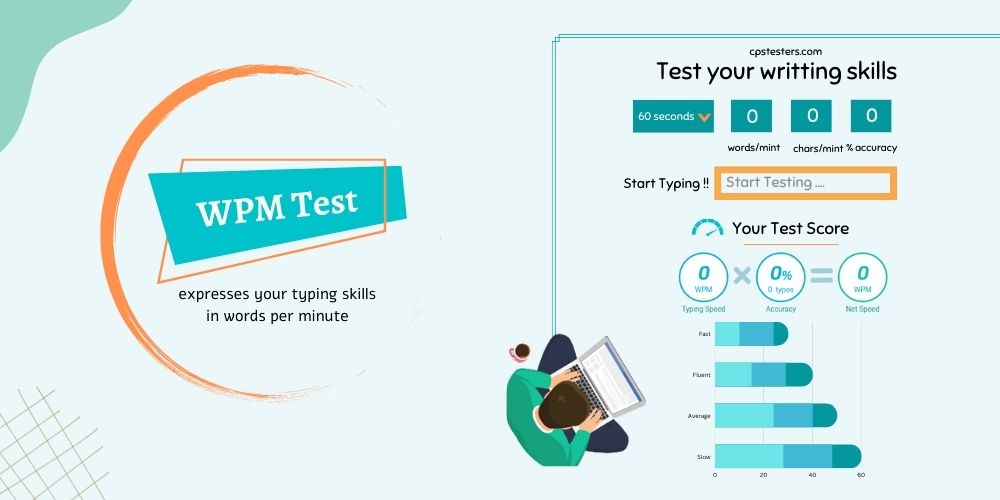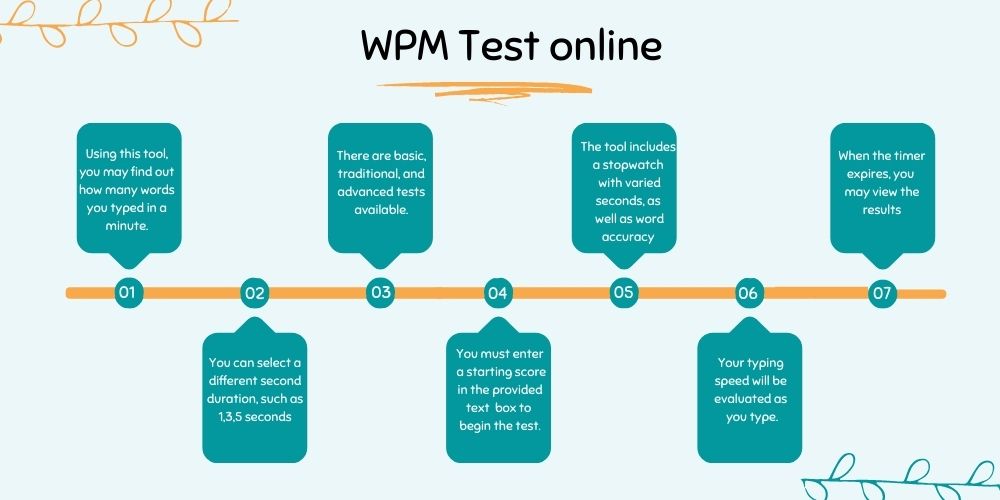| Accuracy | Percentile | |||
|---|---|---|---|---|
| Correct Keystrokes | Correct words | |||
| Wrong Keystrokes | Wrong words |
History
| WPM | Accuracy | Percentile | Keys | Words | Time |
|---|
You May Like These Free Online Tools:
Words per Minute Test
It might not be as easy as it seems to type. You do require certain typing skills for the speed test. The person will need to continuously practice. You can perform a daily WPM test to reach your typing speed objective. This exercise measures your word-per-minute output.
You can assess your level of typing proficiency by utilizing this online WPM typing test tool. The Word per minute test not only determines your typing skills per minute but also concentrates on helping you get better at accuracy. Utilizing the accuracy percentage, you may determine how many words you wrote in a minute. The test’s outcome is determined by two variables. the precision and speed of typing. You should be aware that dividing a long word counts as well.
You can select from six different typing speed testing methods based on your needs. Use the 1-minute or 2-minute testing engine to gauge your typing speed. Use the 10- or 5-minute exam if you wish to practice typing.
Why do I Need a Typing Speed Test?
Simply stated, our typing test wpm allows you to evaluate your typing speed with time and helps you better assess your present skills. This is a necessary step in developing your full potential and determining how much time to devote to daily typing exercises.
For instance, it is advised to assess your typing skills before switching to the 10-finger typing method and starting your practice. This enables you to compare your progress with the 10-finger approach to your previous typing method later on and perform further typing tests using all ten fingers.

You can utilize the typing words per minute test to routinely check your typing speed and observe how you have improved through everyday use if you are already comfortable with your typing abilities and did not train for a long time.
WPM Test Online
To assess your typing speed, use our online typing test. To give you a quick and simple way to gauge your typing speed, we created this no cost typing test. It can help you gauge your development as you practice typing by giving you a sense of how well you are doing.
- Using this tool, you can find out exactly how many words you have typed in a minute.
- There are basic, traditional, and advanced tests available.
- The tool includes a stopwatch with varied seconds, as well as word accuracy, the number of words you typed in a minute, and the total number of typos.
- You can select a different second duration, such as 1,3,5 seconds.
- You must enter a starting score in the provided text box to begin the test.
- Your typing speed will be evaluated as you type.
- When the timer expires, you may view the results. You can also share these results ad tests with your mates.
You Can Check The Keyboard Through Keyboard Test Online Before Typing Test!
The Typing Complexity
An individual user is able to select any level of typing complexity. The user has unrestricted access and is no cost to use.
Easy
Choosing this mode will assist beginners in practicing words per minute. It is a straightforward and simple typing method for new users.
Medium
This typing mode is one level more complex than Easy. This mode is accessible to users who have passed the learning phase.
Hard
The hardest level to raise your typing score is Hard. For officially employed professionals only.
Why does Typing Speed Matter?
You may concentrate on your main task by using touch typing. You experience significant productivity gains when you are less preoccupied with your typing speed. It makes sure to give a result that is better and of top standard. Your work will be far more valued, and you’ll make a lot fewer typing mistakes. You would be able to speak more clearly and quickly.
How can you upgrade your Typing Speed?
You need to think of a way to increase your typing speed if you want to improve your job proficiency. But how do you go about doing it?
Here are some effective suggestions for enhancing your typing:
Correct Typing Methods
You can improve your typing speed by employing suitable typing practices. The touch-typing method, which requires users to memorize the keys and maintain a good hand position on their keyboard, is recommended by several specialists.
Choosing the Finest Keyboard
For typing tasks, experts advise utilizing the best keyboard. The main area where you should feel comfortable is at the keyboard.
Does online typing tests help to increase typing speed?
In a nutshell, no. A program of this nature can only measure your typing speed. You need to practice if you want to speed up your typing. Of course, you can practice typing with these online typing tests.
Many of you may be wondering why I would need a typing program when I already have Microsoft Word and can practice. Yes, you can practice typing with any word processing program. However, I advise using our online typing test engine to practice as it provides you with a detailed WPM and accuracy report to help you correct your errors.

Even while MS Word also offers an error report, you must manually calculate it each time you exercise. And this may make you lose all your interest in practicing.
By putting all of their attention on speed, practically every student makes this critical error. It would be great if you only focus on typing without mistakes.
Keep in mind that accuracy matters more than speed when typing. For instance, if your accuracy rate is only 85% but your speed is 100 WPM, it will take you a very long time to correct the mistakes. You will observe that your typical typing speed will significantly decrease in the end.
Should I practice Typing regularly?
There isn’t anything better than everyday typing classes, that is for sure. The key to developing your typing abilities is practice. You’ll type more quickly the more often you utilize this typing test.
Your writing abilities will significantly improve if you repeatedly practice typing for ten minutes. The WPM test is designed to support ongoing typist education. We monitor your development so you can see how your typing proficiency and speed improve over time. Having consistent activity is essential for developing proficient typing abilities.
WPM Test Benefits
Anybody using a computer needs to know how to type. You can focus on your work easily as you get more at ease typing. Your focus is diverted from your goal when you type slowly and correct typing errors. Find out how well you type with the help of our advanced typing test.
We provide you with thorough feedback following each exam. It has data on your speed, where you slow down, and the kinds of mistakes you commit. All of those specifics are essential for increasing your speed.
You can register to keep tabs on your advancement. You can check progress charts and have your typing test results saved. The ability to post messages and answer any typing-related queries on our forum is available to registered users who have passed three or more typing assessments.
FAQ’s
1. How do I increase my typing speed?
There seem to be two ways to type more quickly: the quickest method is to learn how to type properly. Playing the typing games is second approach to increase your typing speed. Playing keyboard activities like Nitro Type can improve your typing speed and raise your rating in words per minute.
2. What is the average typing speed?
The average typing rate is 40 words per minute (wpm). Go for a typing speed of 65 to 70 words a minute if you desire to be extremely productive.
3. How do you practice the typing test?
To increase your typing speed, you might adhere to the specified techniques. Regular keyboard practice while adhering to particular typing rules is a wise choice.
4. How good is 32 WPM?
It is superior to 7.13 percent of all of our users. Core strength is the key to touch typing, thus the more you type, the faster you become.
5. Is typing at 100 wpm good?
You’re likely a gamer, hacker, or genius if you can type at 90 words per minute. In any case, you’re doing fantastic! 100 wpm or more: You belong to the top 1% of typists!
6. What is the fastest typing speed anyone has achieved?
The fastest typewriter in the world, according to the Guinness World Records, is Barbara Blackburn, who can type at a high pace of 212 WPM. The fastest typist, as per IBM Corp., is Stella Pajunas Garnand, who can type 216 words in a minute. She recorded this song in 1946.
7. How do you type faster?
You must learn how to posture yourself correctly, use all your fingers, press the right keys without peeking, and prevent errors if you want to write more quickly. You will gain from typing training if you have not learned any one of these skills.
8. How do I find my wpm?
The words per minute test, or WPM test, is the simplest way to gauge typing speed. The “word” consists of 5 characters on average. Simply divide the number of words typed in a minute without any typos by five to determine WPM. Your typing speed would be 20 WPM, for instance, if you were to type 100 words per minute, including spaces.